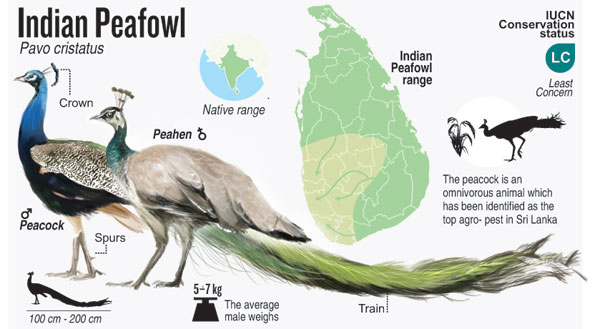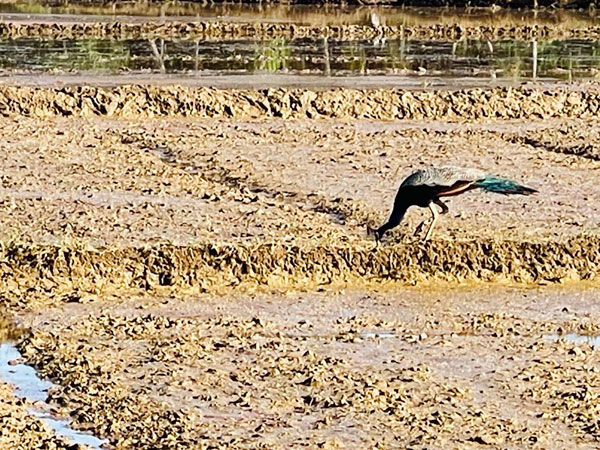News
Peafowl problem: Jade and green bird spreading further and further afield
View(s):By Kasun Warakapitiya
The Indian peafowl, which usually populates the dry zone, is now found in the Western and Central provinces.
Environmental experts and researchers say human activities have created favourable conditions for the proliferation of peacocks and peahens. Their natural predators have also declined.
Colombo University’s Zoology Professor Sampath Seneviratne, a well known bird researcher, said peafowl are now found in the wet zone as well as mountainous areas. He attributes its spread beyond its natural range to an ecological imbalance.

“Indian peafowl (Pavo cristatus) is normally found on open grasslands and scrublands within the dry zone,” Prof. Seneviratne said. “More recently, however, there have been more and more sightings in areas like Colombo, Battaramulla, Wattala, Kiribathgoda, Kalutara, Ambalangoda, Galle, Matara, even Nuwara Eliya.”
Unplanned development and clearing of wet zone forests had upset the ecological balance, he said. The male and female peafowl along with their chicks — that typically prefer dry, open areas — move into Colombo and suburbs as stone-covered sidewalks and cleared land resemble their habitat.
Increased development activity has also driven away natural predators of the peafowl.
“Jackals, fishing cats, jungle cats, leopards, wild boar, civets and mongoose prey on sickly peafowl and pea chicks and eat their eggs, thereby limiting their numbers,” Prof. Senevirate said. “That natural process has been compromised as the predators are now mostly restricted to protected forest areas, wildlife reserves and parks.”
Increasing forest cover by interconnecting protected areas and river banks will encourage new wetland forests, thereby enabling the peafowl’s predators to once again spread and control the numbers, he said.
Peafowl are omnivores, feeding on grain, fruits, saplings, tree shoots, small invertebrates, amphibians, reptiles, and small mammals. If the population keeps rising, it would be a risk to the ecology.
The Agriculture Ministry, too, brands them as pests and has proposed culling.

Pecking at paddy seeds: A juvenile peacock in Akuressa Pic by Priyantha S Dasanayake
Peafowl are known to feed on seeds and grain, said Duminda Priyadharshana, senior research officer at the Hector Kobbekaduwa Agrarian Research and Training Institute (HARTI). Farmers complain the birds even consume newly-planted seeds.
And they also eat vegetable shoots, flowers, and ripening fruit, lamented T. B. Sarath, secretary of the All Island Farmers’ Federation. A group of peafowl — called a muster — can wipe out an acre of sprouting vegetable shoots within a short period of time.
Firecrackers used to repel elephants also frighten predators like jackals, said Mr. Sarath. He is also the convener of the Elephant Protection Group led by farmers.
But farmers oppose culling as they believe the birds are associated with the Kataragama deity. So they use traps, fences, and wires to deter them.
The ministry is discussing with agriculture and wildlife experts to find ways to reduce crop damage, said Ministry Secretary Gunadasa Samarasinghe. There is agreement that scientific methods should be used and they need to be humane, preserve biodiversity, and lawful.
The Department of Wildlife Conservation (DWC) does not have data to confirm that the peafowl population has significantly increased, said director general Chandana Sooriyabandara. But their distribution beyond the dry zone has been observed because desertification of the wet zone has created conditions similar to the birds’ natural habitat.
The DWC is making a combined effort with the Agriculture Ministry. Meanwhile, HARTI has estimated the crop damage caused by animals, including peafowl, and handed a report to the agriculture minister. The DWC is waiting for committees to be set up so authorities can collectively decide on an action plan.
Environmentalists have accused Agriculture Ministry officials and the minister’s advisors of approving “illogical plans” aimed at boosting his popularity (such as the suggestion to export toque macaques to China) rather than seeking environmentally-friendly methods.
Ven. Pahiyangala Ananda Sagara Thera said ministers who have a grasp of the subject must hold the portfolios of wildlife conservation and agriculture. Increasing forest cover is the logical solution to restore the ecology. If one species is culled or sterilised, another species will increase, creating other issues.
The best way to say that you found the home of your dreams is by finding it on Hitad.lk. We have listings for apartments for sale or rent in Sri Lanka, no matter what locale you're looking for! Whether you live in Colombo, Galle, Kandy, Matara, Jaffna and more - we've got them all!

